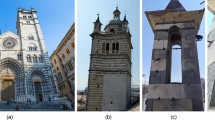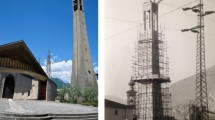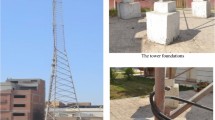Abstract
The paper investigates the dynamic characterisation, the numerical model tuning and the seismic risk assessment of two monumental masonry towers located in Italy: the Capua Cathedral bell tower and the Aversa Cathedral bell tower. Full-scale ambient vibration tests under environmental loads are performed. The modal identification is carried out using techniques of modal extraction in the frequency domain. The refined 3D finite element model (FEM) is calibrated using the in situ investigation survey. The FEM tuning is carried out by varying the mechanical parameters and accounting for the restraint offered by the neighbouring buildings and the role of soil–structure interaction. The assessment of the seismic performance of the bell towers is carried out through a nonlinear static procedure based on the multi-modal pushover analysis and the capacity spectrum method. Through the discussion of the case studies, the paper shows that the modal identification is a reliable technique that can be used in situ for assessing the dynamic behaviour of monumental buildings. By utilising the tuned FEM of the towers, the theoretical fundamental frequencies are determined, which coincide with the previously determined experimental frequencies. The results from seismic performance assessment through a pushover analysis confirm that the masonry towers in this study are particularly vulnerable to strong damage even when subjected to seismic events of moderate intensity.

(credits: Ugo Persice Pisanti)


(credits: Agostino De Maio)















Similar content being viewed by others
Abbreviations
- a :
-
Parameter of the yield Drucker–Prager surface (–)
- d :
-
Soil depth (mm)
- E :
-
Young’s modulus (MPa)
- E f :
-
Young’s modulus of foundation (MPa)
- E b :
-
Young’s modulus of superstructure masonry (MPa)
- E s :
-
Secant Young’s modulus (MPa)
- E t :
-
Tangent Young’s modulus (MPa)
- f :
-
Frequency (Hz)
- f c :
-
Compressive strength (MPa)
- f t :
-
Tensile strength (MPa)
- f AVT :
-
Natural frequencies from ambient vibration test (Hz)
- f FEM :
-
Natural frequencies from finite element model (Hz)
- F AVT,i :
-
ith modal force vectors from ambient vibration test (–)
- F FEM,i :
-
ith modal force vectors from finite element model (–)
- F o :
-
Amplification factor (–)
- h :
-
Bell tower height (m)
- K :
-
Parameter of the yield Drucker–Prager surface
- k n :
-
Normal stiffness (MPa)
- k v :
-
Vertical stiffness (MPa)
- m :
-
Mass (kg)
- M :
-
Mass matrix (kg)
- N :
-
Number of the experimental mode shapes (–)
- PGA:
-
Peak ground acceleration (g)
- PGALS :
-
Reference peak ground acceleration for the life safe limit state (g)
- PSD:
-
Power spectral density (g2/Hz)
- P VR :
-
Probability of exceedance (–)
- S a :
-
Spectral acceleration (m/s2)
- S d :
-
Spectral displacement (cm)
- t :
-
Soil layer thickness (m)
- T R :
-
Return period (years)
- V :
-
Base shear (MN)
- W :
-
Weight (kN)
- α i :
-
ith modal mass ratio (–)
- α LS :
-
Safety index at life safe limit state (–)
- Γ i :
-
ith modal participation factor (–)
- δ :
-
Lateral displacement (m)
- δ top :
-
Roof lateral displacement (m)
- δ y :
-
Displacement in y-direction (m)
- ε t :
-
Tensile strain (‰)
- η i :
-
Error (–)
- η :
-
Weighted arithmetic mean error (–)
- μ :
-
Mass density (kg/m3)
- ν :
-
Poisson’s ratio (–)
- Φ i :
-
ith mode shape (–)
References
Abruzzese D, Ferraioli M, Miccoli L, Vari A (2008) Seismic improvement of masonry towers. In: Proceedings of 8th international seminar on structural masonry. Istanbul, pp 395–403
Abruzzese D, Miccoli L, Vari A, Ferraioli M, Mandara A, Froncillo S (2009) Dynamic investigations on medieval masonry towers: seismic resistance and strengthening techniques. In: Proceedings of the international conference on protection of historical buildings. Rome, pp 1207–1213
Abruzzese D, Miccoli L, Vari A, Ferraioli M, Mandara A, Froncillo S (2009) Dynamic investigations on medieval masonry towers: vibration measurement and structural identification. In: Proceedings of the international conference on protection of historical buildings. Rome, 807–813
Abruzzese D, Miccoli L, Yuan JL (2009c) Mechanical behavior of leaning masonry Huzhu Pagoda. J Cult Herit 10:480–486
ASCE (2007) Seismic rehabilitation of existing buildings. Standard ASCE/SEI 41-06. American Society of Civil Engineers, Reston
ASTM C1196-91 (1991) Standard test method for in situ compressive stress within solid unit masonry—Estimated using flat jack measurements
ATC (1996) Seismic evaluation and retrofit of concrete buildings. Report ATC-40. Applied Technology Council, Redwood City
Bayraktar A, Türker T, Sevım B, Altunisik AC, Yildirim F (2009) Modal parameter identification of Hagia Sophia bell-tower via ambient vibration test. J Nondestruct Eval 28:37–47
Bendat JS, Piersol AG (1993) Engineering applications of correlation and spectral analysis. Wiley Interscience, New York
Bennati S, Nardini L, Salvatore W (2005) Dynamic behavior of a medieval masonry bell tower. Part II: measurement and modelling of the tower motion. J Struct Eng Asce 131:1656–1664
Bernardeschi K, Padovani C, Pasquinelli G (2004) Numerical modelling of the structural behaviour of Buti’s bell tower. J Cult Herit 5:371–378
Betti M, Galano L (2012) Seismic analysis of historic masonry buildings: the Vicarious Palace in Pescia (Italy). Buildings 2:63–82
Betti M, Vignoli A (2011) Numerical assessment of the static and seismic behaviour of the Basilica of Santa Maria all’Impruneta (Italy). Constr Build Mater 25:4308–4324
Brincker R, Zhang LM, Andersen P (2000) Modal identification from ambient responses using frequency domain decomposition. In: Proceedings of the 18th international modal analysis conference (IMAC), San Antonio
Cakir F, Uckan E, Shen J, Seker S, Akbas B (2016) Seismic performance evaluation of slender masonry towers: a case study. Struct Des Tall Spec 25:193–212
Calderini C, Lagomarsino S (2006) A micromechanical inelastic model for historical masonry. J Earthq Eng 10:453–479
Carpinteri A, Invernizzi S, Lacidogna G (2005) In situ damage assessment and nonlinear modelling of a historical masonry tower. Eng Struct 27:387–395
Casolo S (2004) Modelling in-plane micro-structure of masonry walls by rigid elements. Int J Solids Struct 41:3625–3641
Casolo S, Milani G, Uva G, Alessandri C (2013) Comparative seismic vulnerability analysis on ten masonry towers in the coastal Po Valley in Italy. Eng Struct 49:465–490
Cerioni R, Brighenti R, Donida G (1995) Use of incompatible displacement modes in a finite element model to analyze the dynamic behavior of unreinforced masonry panels. Comput Struct 57:47–57
Chopra AK, Goel RK (2004) A modal pushover analysis procedure to estimate seismic demands for unsymmetric-plan building. Earthq Eng Struct D 33:903–927
Cressie N (2015) Statistics for spatial data. Wiley, Hoboken
D’Ambrisi A, Mariani V, Mezzi M (2012) Seismic assessment of a historical masonry tower with nonlinear static and dynamic analyses tuned on ambient vibration tests. Eng Struct 36:210–219
De Sortis A, Antonacci E, Vestroni F (2005) Dynamic identification of a masonry building using forced vibration tests. Eng Struct 27:155–165
Eurocode, CEN (2004) 8: Design of structures for earthquake resistance—Part 1: General rules, seismic actions and rules for buildings (EN 1998-1: 2004). European Committee for Normalization, Brussels
Fajfar P (1999) Capacity spectrum method based on inelastic demand spectra. Earthq Eng Struct D 28:979–993
Fajfar P, Kilar V, Marusic D, Perus I, Magliulo G (2005) The extension of the N2 method to asymmetric buildings. In: Proceedings of the 4th European workshop on the seismic behaviour of irregular and complex structures (No. 41)
FEMA (2005) Improvement of nonlinear static seismic analysis procedures. Report FEMA 440. Federal Emergency Management Agency, Redwood City
Ferraioli M (2015) Case study of seismic performance assessment of irregular RC buildings: hospital structure of Avezzano (L’Aquila, Italy). Earthq Eng Eng Vib 14:141–156
Ferraioli M, Abruzzese D, Miccoli L, Vari A, Di Lauro G (2010) Structural identification from environmental vibration testing of an asymmetric-plan hospital building in Italy. In: COST ACTION C26: Urban habitat constructions under catastrophic events—Proceedings of the final conference, pp 981–986
Ferraioli M, Lavino A, Mandara A (2014a) Behaviour factor of code-designed steel moment-resisting frames. Int J Steel Struct 14(2):243–254
Ferraioli M, Avossa AM, Lavino A, Mandara A (2014b) Accuracy of advanced methods for nonlinear static analysis of steel moment-resisting frames. Open Constr Build Technol J 8:310–323
Ferraioli M, Avossa AM, Mandara A (2014c) Assessment of progressive collapse capacity of earthquake-resistant steel moment frames using pushdown analysis. Open Constr Build Technol J 8:324–336
Foraboschi P, Vanin A (2013) Non-linear static analysis of masonry buildings based on a strut-and-tie modeling. Soil Dyn Earthq Eng 55:44–58
Gambarotta L, Lagomarsino S (1997) Damage models for the seismic response of brick masonry shear walls. Part I and II. Earthq Eng Struct D 26:441–462
Gentile C, Saisi A, Cabboi A (2015) Structural identification of a masonry tower based on operational modal analysis. Int J Archit Herit 9:98–110
Ivorra S, Pallarés FJ (2006) Dynamic investigation on a masonry bell tower. Eng Struct 28:660–667
Júlio E, Rebelo C, Costa D (2008) Structural assessment of the tower of the University of Coimbra by modal identification. Eng Struct 30:3468–3477
Kilar V, Fajfar P (2001) On the applicability of pushover analysis to the seismic performance evaluation of asymmetric buildings. Eur Earthq Eng 15:20–31
Lagomarsino S, Cattari S (2015) PERPETUATE guidelines for seismic performance-based assessment of cultural heritage masonry structures. Bull Earthq Eng 13:13–47
Lemos JV (2007) Discrete element modelling of masonry structures. Int J Archit Herit 1:190–213
Lofti HR, Shing PB (1994) Interface model applied to fracture of masonry structures. J Struct Eng Asce 120:63–81
Lourenço PB (2002) Computations of historical masonry constructions. Prog Struct Eng 4(3):301–319
Lourenço PB, Roque J (2006) Simplified indexes for the seismic vulnerability of ancient masonry buildings. Constr Build Mater 20:200–208
Lourenço PB, Rots J (1997) A multi-surface interface model for the analysis of masonry structures. J Eng Mech Asce 123:660–668
Lourenço PB, Rots J, Blaauwendraad J (1998) Continuum model for masonry: parameter estimation and validation. J Struct Eng Asce 124:642–652
Lourenço PB, Krakowiak KJ, Fernandes FM, Ramos LF (2007) Failure analysis of Monastery of Jerónimos, Lisbon: how to learn from sophisticated numerical models. Eng Fail Anal 14:280–300
Luciano R, Sacco E (1998) A damage model for masonry structures. Eur J Mech A Solid 17:285–303
LUSAS Finite element system (2012) Lusas theory manual, FEA Ltd
Marfia S, Sacco E (2012) Multiscale damage contact-friction model for periodic masonry walls. Comput Method Appl Mech 205:189–203
Milani G, Russo S, Pizzolato M, Tralli A (2012) Seismic behavior of the San Pietro di Coppito church bell tower in L’Aquila, Italy. TOCIEJ 6:131–147
National Instruments (2003) LabView measurements manual. National Instruments, Austin
NTC (2008) Norme Tecniche per le Costruzioni. DM del 14 gennaio 2008. Gazzetta Ufficiale 29—Istruzioni per l’applicazione delle « Nuove norme tecniche per le costruzioni » . Circolare del 2 febbraio 2009. Gazzetta Ufficiale 47. Ministero per le Infrastrutture e Trasporti (Italian Building Code. Ministerial decree of Jan 14th, 2008. Official gazette 29—Guidelines for the application of the new Building Code. Document of Feb 2nd, 2009. Official gazette 47. Ministry of Infrastructure and Transport) Rome
Orduña A, Lourenço PB (2005a) Three-dimensional limit analysis of rigid blocks assemblages. Part I: torsion failure on frictional interfaces and limit analysis formulation. Int J Solids Struct 42:5140–5160
Orduña A, Lourenço PB (2005b) Three-dimensional limit analysis of rigid blocks assemblages. Part II: load-path following solution procedure and validation. Int J Solids Struct 42:5161–5180
Osmancikli G, Uçak S, Turan FN, Türker T, Bayraktar A (2012) Investigation of restoration effects on the dynamic characteristics of the Hagia Sophia bell-tower by ambient vibration test. Constr Build Mater 29:564–572
PCM (2011) Valutazione e riduzione del rischio sismico del patrimonio culturale con riferimento alle norme tecniche per le costruzioni di cui al DM 14 gennaio 2008. Presidenza del Consiglio dei Ministri (Assessment and reduction of seismic risk of cultural heritage in relation to the Building Code included in the Ministerial decree of January 14th, 2008. Presidency of the Council of Ministers) Rome
Peeters B (2000) System identification and damage detection in civil engineering. Ph.D. dissertation, Katholieke Universiteit Leuven
Peña F, Lourenço PB, Mendes N, Oliveira DV (2010) Numerical models for the seismic assessment of an old masonry tower. Eng Struct 32:1466–1478
Preciado A (2015) Seismic vulnerability and failure modes simulation of ancient masonry towers by validated virtual finite element models. Eng Fail Anal 57:72–87
Ramos LF, Marques L, Lourenco PB, De Roeck G, Campos-Costa A, Roque J (2010) Monitoring historical masonry structures with operational modal analysis: two case studies. Mech Syst Signal Process 24:1291–1305
Roca P, Cervera M, Gariup G (2010) Structural analysis of masonry historical constructions. Classical and advanced approaches. Arch Comput Methods Eng 17(3):299–325
Russo G, Bergamo O, Damiani L, Lugato D (2010) Experimental analysis of the “Saint Andrea” masonry bell tower in Venice. A new method for the determination of “tower global Young’s modulus E”. Eng Struct 32:353–360
SBAAAS CE-BN (2008) Soprintendenza per i Beni Ambientali, Architettonici, Artistici e Storici delle Provincie di Caserta e Benevento, Progetto Interventi Sperimentali Strutture snelle ad elevato rischio. Campanile della Cattedrale di S. Paolo (Office for environmental, architectural, artistic and historical heritage protection office of Caserta and Benevento areas. Project for interventions on tall structures with high risk. Saint Paul Cathedral bell tower). Il Cenacolo s.r.l. Centro Studi e Ricerche, Laboratorio Analisi
Schlegel R (2004) Numerische Berechnung von Mauerwerkstrukturen in homogenen und diskreten Modellierungsstrategien (Numerical simulations of masonry structures by homogenized and discrete modeling strategies). Ph.D. dissertation, University of Weimar
Tomaszewska A, Szymczak C (2012) Identification of the Vistula Mounting tower model using measured modal data. Eng Struct 42:342–348
Van Overschee P, De Moor BL (2012) Subspace identification for linear systems: theory—implementation—applications. Springer, New York
Zucchini A, Lourenço PB (2007) Mechanics of masonry in compression: results from a homogenisation approach. Comput Struct 85:193–204
Acknowledgments
The authors wish to express their gratitude to Mr. Salvatore Froncillo, Mr. Luigi Aruta and Mr. Alessandro Vari for their important support in the on-site measurements carried out on both towers.
Author information
Authors and Affiliations
Corresponding author
Rights and permissions
About this article
Cite this article
Ferraioli, M., Miccoli, L., Abruzzese, D. et al. Dynamic characterisation and seismic assessment of medieval masonry towers. Nat Hazards 86 (Suppl 2), 489–515 (2017). https://doi.org/10.1007/s11069-016-2519-2
Received:
Accepted:
Published:
Issue Date:
DOI: https://doi.org/10.1007/s11069-016-2519-2




